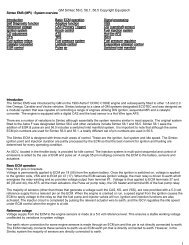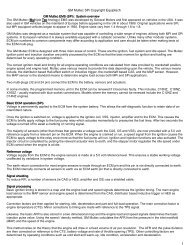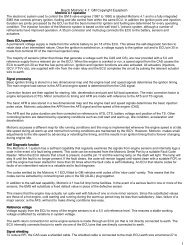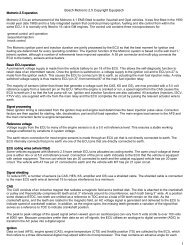Create successful ePaper yourself
Turn your PDF publications into a flip-book with our unique Google optimized e-Paper software.
4<br />
Bosch Motronic <strong>1.1</strong>/1.3 BMW Copyright Equiptech<br />
to distribute the HT current from the coil secondary terminal to each spark plug in firing order.<br />
Cylinder Identification (CID)<br />
An cylinder identification sensor is used to identify cylinder firing sequence. The sensor is connected around the HT lead of<br />
cylinder number 4 (4 cylinder) or cylinder number 6 (6 cylinder) adjacent to the distributor. As the HT pulses travel along the HT<br />
lead, a small AC signal is induced in the sensor and returned to the ECU. The ECU utilises an ADC to transform the signal into a<br />
digital pulse.<br />
Fuel injection<br />
The Motronic ECU contains a fuel map with an injector opening time for basic conditions of speed and load. Information is then<br />
gathered from engine sensors such as the AFS, CAS, CTS, and TS. As a result of this information, the ECU will look-up the<br />
correct injector pulse duration right across the engine rpm, load and temperature range.<br />
The injectors are arranged in two banks with injectors 1 and 3 (4 cylinder) or 1, 3 and 5 (6 cylinder comprising one bank, and<br />
injectors 2 and 4 (4 cylinder) or 2, 4 and 6 (6 cylinder) making up the other bank. Each bank is connected to the ECU via an<br />
independent ECU pin.<br />
The Motronic <strong>1.1</strong> & 1.3 multi-point injection system pulses the injectors semi-sequentially and once every two engine revolutions.<br />
During engine start-up below 600 rpm the ECU pulses all injectors simultaneously. Once 600 rpm has been attained and if the<br />
ECU has received a signal from the CID sensor, each injector bank will be pulsed alternatively according to which pair of<br />
cylinders are approaching TDC. If a signal is not received from the CID sensor the injectors will remain on simultaneous<br />
operation. However, if the CID sensor subsequently sends a signal to the ECU after the engine has commenced running, the<br />
ECU will pulse the injectors semi-sequentially after the next deceleration phase - even if the CID sensor then ceases to send a<br />
signal.<br />
During start-up from cold, injector pulse duration is increased to provide a richer air/fuel mixture and pulse frequency is also<br />
increased. In addition, the ignition timing is also retarded. Injector frequency & pulse duration and degree of timing retard depend<br />
upon the engine temperature both during start-up and immediately afterwards. If the engine is restarted within one minute of the<br />
first start occurance, less overall fuel is injected to reduce the risk of fuel flooding into the engine.<br />
Fuel injectors<br />
The fuel injector is a magnetically operated solenoid valve that is actuated by the ECU. Voltage to the injectors is applied from<br />
the main relay and the earth path is completed by the ECU for a period of time (called pulse duration) of between 1.5 and 10<br />
milliseconds. The pulse duration is very much dependant upon engine temperature, load, speed and operating conditions. When<br />
the magnetic solenoid closes, a back EMF voltage of up to 60 volts is initiated.<br />
The fuel injectors are mounted in the inlet stubs to the engine inlet valves so that a finely atomised fuel spray is directed onto the<br />
back of each valve. Since the injectors are pulsed in two banks, fuel will briefly rest upon the back of a valve before being drawn<br />
into a cylinder.<br />
Air Flow Sensor (AFS)<br />
The AFS is located between the air filter and the throttle body. As air flows through the sensor it deflects a spring loaded vane<br />
(flap). The greater the volume of air, the more will the flap be deflected. The vane is connected to a wiper arm which wipes a<br />
potentiometer track and so varies the resistance of the track. This allows a variable voltage signal to be returned to the ECU. The<br />
voltage signal varies in proportion to the volume of air that flows through the vane.<br />
Three wires are used by the circuitry of this sensor and it is often referred to as a three wire sensor. A 5 volt reference voltage is<br />
applied to the resistance track with the other end connected to the AFS earth return circuit. The third wire is connected to the<br />
wiper arm.<br />
From the voltage returned, the ECU is able to calculate the volume of air (load) entering the engine and this is used to calculate<br />
the main fuel injection duration. To smooth out inlet pulses, a damper is connected to the AFS vane. The AFS exerts a major<br />
influence on the amount of fuel injected.<br />
ATS<br />
The ATS is mounted in the AFS inlet tract and measures the air temperature before it enters the inlet manifold. Because the<br />
density of air varies in inverse proportion to the temperature, the ATS signal allows more accurate assessment of the volume of<br />
air entering the engine. However, the ATS has only a minor correcting effect on ECU output.<br />
The open circuit supply to the sensor is at a 5.0 volt reference level and the earth path is through the AFS earth return circuit.<br />
The ATS operates on the NTC principle. A variable voltage signal is returned to the ECU based upon the air temperature. This<br />
signal is approximately 2.0 to 3.0 volts at an ambient temperature of 20° C and reduces to about 1.5 volt as the temperature rises<br />
to around 40° C.<br />
CO pot






